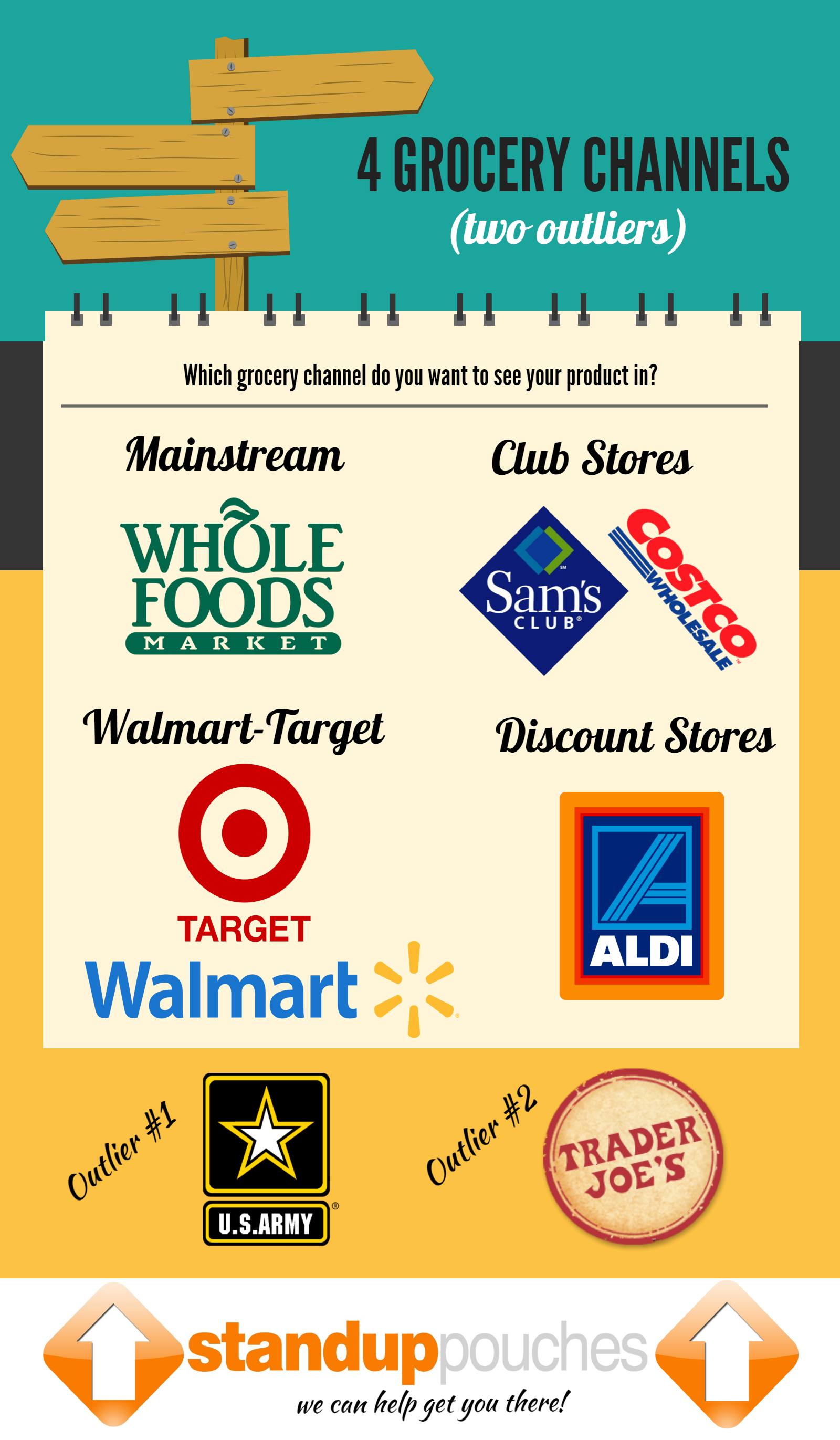How to market your food product is a question that must be answered by companies large and small every single day. Whether that product is an established brand or a potential new item not yet released on store shelves, marketers are constantly trying to get an edge over their competitors using new slogans and jingles, fancy new ingredients, and of course the right type of retail packaging that will stand out on a store shelf. What’s interesting is how different the packaging needs to be at each of the main grocery channels. In the “old days” how to market your food product was the same over and over but now there are so many opportunities that often require a completely different marketing approach and mindset. As experts in the flexible packaging industry we are keenly aware of these channels and the different types of packaging that perform better than others in each of them. These channels are as follows:
Mainstream Grocery:
Your mainstream grocery channel includes your local grocery stores, national chains like Krogers as well as natural foods giant Whole Foods. What’s interesting is how to market food products in this particular channel is probably the most diverse as these stores tend to have few restrictions on the type of retail packaging used so long as it fits in the available space provided. Types of retail packaging include folding cartons (traditional cereal boxes), rigid plastic containers (detergent, beverages), glass bottles and jars, and of course flexible packaging such as barrier bags.
Club Stores
How to market a food product at the club store channel starts to get more complex. Gone are traditional store shelves and instead you are dealing with packaging on open pallets or in warehouse racks and massive coolers and freezers packed to the gills. Here, your packaging must be thoroughly thought out. Can you get creative and develop a multi-pack or jumbo size that you would probably never consider or think about at the mainstream grocery level? The types of packaging that thrive here are massive folding cartons, not corrugated boxes but folding cartons with inner liners for baking mixes and snacks among other things. Large clamshells and blisters are also prevalent for multiple jars and tubs of spices and non-food items. Flexible packaging such as jumbo printed barrier bags for food are all over the club store channel as they can be designed to mimic smaller sizes used in mainstream grocery stores (only bigger) and they have all the convenience factors consumers want such as ziplocks and pour spouts and stout bottom gussets so they can stand erect not only at the club stores but in the consumer’s cupboard.
Walmart/Target
How to market a food product (as far as packaging goes) at Walmart and Target isn’t much different than mainstream grocery stores as they have very little restrictions as to the types of packaging you use. You’ll see glass jars and canisters along with printed folding cartons and of course flexible packaging such as barrier bags for food and frozen products. One of the big differences here is the distribution and supply chain as orders are much larger and the room for error and hiccups is much smaller. Walmart and Target are retail machines and if you have a problem with getting product packaged properly or delivered on time your days there are numbered.
Discount Stores
Examples of discount stores such as Dollar General, Aldi’s, and Dollar General may elicit feelings of “cheap” or lower grade but make no mistake about it, these companies are well run and well-oiled retail machines. How to market your food product here is all about the lowest possible price, odd lots of products that didn’t sell well or enough at the mainstream or even club level and now here is where they come to be picked through and sold at rock bottom prices. While you will see traditional retail packaging such as folding cartons and plastic canisters, it is not a mistake that many of the items on these shelves are in barrier bags for food like custom printed stand up pouches. Here, the layers of barrier film used help extend the shelf life of the products while the custom printing continues to look fresh and inviting and not fade or become distorted as folding cartons and boxes tend to do over longer periods of time.
Outliers: US Military and Trader Joes
These channels stand alone as they are unique unto themselves. Each of these have specific rules and requirements as to the types of accepted packaging and how to market a food product here is definitely different than all the other channels. You will see all types of packaging but again with very specific and unique rules and regulations. Tread lightly and know what you are doing, these channels are not for the retail faint of heart!
In closing, how you market your food product in each of these grocery channels is different and unique. While some accept all types of packaging, some only allow a few. It is strongly recommended that you work with a food broker that understands these channels and knows how to maximize your exposure and ultimately help you sell more products…while at the same time; retail packaging can make or break your success once your product is on a store shelf. It is strongly recommended that you work with a packaging partner that understands not only how to contain your food product, whatever it is, but to protect it and keep it fresher for longer while helping it to stand out and get noticed by consumers.







